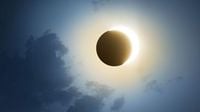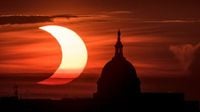On March 29, 2025, a partial solar eclipse will captivate viewers across Europe, the UK, and parts of North America. This celestial event, where the Moon will obscure a significant portion of the Sun, is expected to start at around 10:00 AM GMT and will reach its peak around 11:00 AM GMT. The eclipse will be particularly striking in the UK, where people in northern and western regions will enjoy the best views, with Scotland and Northern Ireland potentially seeing up to 45% of the Sun covered.
The eclipse will occur during a new moon phase, coinciding with a supermoon, which means the Moon will appear larger in the sky than usual. This unique alignment presents a rare opportunity for both amateur and experienced skywatchers alike. According to the Royal Astronomical Society, this will be the only partial solar eclipse visible in the UK this year, making it a must-see event for astronomy enthusiasts.
In the UK, the eclipse will begin at 9:56 AM and end at 12:14 PM. The peak visibility will vary by location, with London experiencing around 30% coverage of the Sun, while areas in the Outer Hebrides could see as much as 47% obscured. The best views in North America will be in the northeastern states, particularly in Maine and New Hampshire, where up to 53% of the Sun's diameter will be covered.
Weather conditions will play a crucial role in visibility. The Met Office has forecasted clear skies over many parts of England, particularly in the south, while northern regions may experience cloud cover and rain. Stephen Dixon, a spokesperson for the Met Office, noted, "The north west of Scotland, which has the best window for seeing the partial solar eclipse, is unfortunately going to see rain and cloudy skies. However, those further south in England should see some break in the cloud."
As the Moon moves in front of the Sun, it will create a crescent shape that will be visible for a couple of hours. This phenomenon is fascinating not just for its aesthetic beauty but also for its scientific implications. TenneT, the Dutch transmission system operator, has been preparing for the eclipse's impact on energy generation, especially given the significant amount of solar power produced in the Netherlands. They anticipate a maximum reduction in solar production of 4.6 GW if the weather remains clear.
Fred van Halm from TenneT explained, "Due to the increase in installed capacity, the power decrease and increase will be considerably steeper than during the solar eclipse we had in 2022. The maximum offtake is 82 megawatts per minute, and the maximum increase is 138 megawatts per minute. We have to be able to absorb that to keep our system in balance."
For those planning to watch the eclipse, safety is paramount. Experts have warned that looking directly at the Sun, even during a partial eclipse, can cause serious eye damage. Dr. Robert Massey of the Royal Astronomical Society emphasized the importance of using proper solar eclipse glasses or alternative viewing methods, such as a pinhole projector made from two pieces of cardboard. He stated, "You mustn’t look at it with the naked eye; you mustn’t look at it with a telescope unless you have the right kind of filters."
For viewers in Canada, the eclipse will be especially dramatic, with regions like Nunavut experiencing up to 90% of the Sun obscured. This is a significant opportunity for Canadians, as similar solar events are rare. Observers in eastern provinces such as Quebec and New Brunswick will also be treated to a spectacular view.
As the partial solar eclipse approaches, many are excited about the chance to witness this cosmic event. Anna Gammon-Ross, Senior Planetarium Astronomer at Royal Museums Greenwich, remarked, "This is an excellent chance to go out, look – safely – and to be able to see the movement of the solar system for yourself. It's such a wonderful way to just connect to everything happening and see it all in action."
In addition to the immediate visual spectacle, the eclipse holds astrological significance for many. Astrologers suggest that eclipses can bring about shifts in personal energy and may influence people's emotions and decisions. For instance, Aries might feel a surge of confidence, while Taurus could experience a fresh start after challenging times. Each star sign is believed to be affected differently, making the eclipse a point of reflection and potential change.
In conclusion, the partial solar eclipse on March 29, 2025, promises to be a captivating event for viewers across the UK, Europe, and North America. With preparations underway to mitigate the impact of the eclipse on energy supplies and safety measures in place for viewers, this celestial phenomenon is set to inspire wonder and curiosity. Whether you’re an astronomy enthusiast or simply looking to experience something extraordinary, this eclipse is not to be missed.









